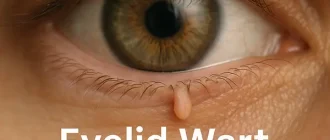Have you ever experienced a dark spot appearing in the vision of one eye? This symptom can be alarming, and rightfully so. Understanding the possible causes and implications is crucial for protecting your vision and overall health.
Causes Breakdown of Dark Spots in Vision
Is It a Serious Problem?
A dark spot in your vision could be as simple as eye strain or as complex as a sign of a medical emergency. While not all cases are critical, it’s vital to address this symptom promptly with an eye care professional. Here’s a breakdown of possible causes:
- Floaters and Vitreous Detachment
Floaters are tiny clumps of protein or cells inside the vitreous humor (the gel-like substance in your eye). Sometimes, these floaters can appear as dark spots. If accompanied by flashes of light, it might indicate vitreous detachment—a condition where the vitreous pulls away from the retina. - Macular Degeneration
Age-related macular degeneration (AMD) affects the macula, the central part of the retina, and can lead to dark spots in your central vision. AMD is a leading cause of vision loss in older adults. - Retinal Detachment
A detached retina often starts with symptoms like a dark curtain or spot in your vision. This is a medical emergency that requires immediate attention to prevent permanent vision loss. - Optic Neuritis
Inflammation of the optic nerve, often linked to conditions like multiple sclerosis, can cause dark spots and blurred vision. Other symptoms may include pain when moving the eye. - Diabetic Retinopathy
High blood sugar can damage the blood vessels in your retina, leading to bleeding and dark spots. Diabetic retinopathy is a common complication of diabetes and requires medical management.
Symptom Onset Timeline
| Condition | Timeline |
|---|---|
| Floaters and Vitreous Detachment | Slow (Weeks) |
| Macular Degeneration | Gradual (Months) |
| Retinal Detachment | Rapid (Days) |
| Optic Neuritis | Moderate (Weeks) |
| Diabetic Retinopathy | Chronic (Years) |
How Do You Recognize the Symptoms?
Dark spots in vision can present differently depending on the underlying cause. Here are some signs to watch for:
- Floating shapes or specks that move when you move your eyes, sometimes appearing as clusters or small cobwebs. These floaters often become more noticeable against bright backgrounds like the sky or a white wall.
- Blurred or distorted central vision that may make reading or focusing on details more difficult. This can vary in severity and sometimes fluctuate throughout the day.
- A sudden increase in floaters, flashes of light, or a shadow creeping across your peripheral vision, which could signify an urgent issue like retinal detachment.
- Pain or discomfort in the eye, especially during movement, which may also be accompanied by redness or swelling depending on the cause.
- Gradual loss of vision over weeks or months, sometimes paired with changes in color perception or the appearance of hazy or dim areas within your visual field.
Did You Know?
According to the American Academy of Ophthalmology, more than 50% of people aged 50 and older will experience floaters due to vitreous detachment. While usually harmless, it’s essential to distinguish them from more severe conditions like retinal detachment. Source: AAO.org
What Can You Do About It?
Immediate Steps
If you notice a new or worsening dark spot in your vision, follow these steps:
- Do not ignore it. Promptly schedule an appointment with an ophthalmologist or optometrist.
- Note additional symptoms. Record whether you experience flashes, changes in color perception, or pain.
- Avoid eye strain. Reduce screen time and ensure good lighting when reading or working.
Medical Treatments
Your eye doctor may recommend various treatments depending on the cause:
- For floaters, observation is often sufficient unless they impair vision severely. In extreme cases, vitrectomy surgery might be considered.
- For macular degeneration, treatments include anti-VEGF injections to slow progression.
- Retinal detachment typically requires surgery such as pneumatic retinopexy or scleral buckle.
- Diabetic retinopathy management focuses on controlling blood sugar and may include laser therapy.
How Can You Prevent It?
While some causes of dark spots are unavoidable, like age-related changes, you can take proactive steps to reduce your risk:
- Maintain regular eye exams. Early detection of conditions like diabetic retinopathy or AMD can preserve vision. Scheduling annual or biannual exams ensures that your eye care provider can identify potential problems before they escalate into serious conditions.
- Adopt a healthy lifestyle. Balanced nutrition, exercise, and smoking cessation are crucial for retinal health. Incorporate foods rich in antioxidants, such as leafy greens, carrots, and fish high in omega-3 fatty acids. Regular physical activity improves blood flow to the retina, keeping it nourished and functioning well.
- Control underlying conditions. If you have diabetes or hypertension, keep these conditions well-managed. Work closely with your healthcare provider to monitor your blood sugar and blood pressure, as fluctuations can directly impact your vision. Taking medications as prescribed and adhering to a healthy lifestyle plan are essential components.
- Protect your eyes. Wear sunglasses that block UV rays and use protective eyewear during activities that risk eye injury. Look for sunglasses labeled 100% UVA and UVB protection. For those working with tools or engaging in sports, durable protective goggles can prevent debris or impacts from causing damage.
Editorial Advice
A dark spot in one eye’s vision is more than just a visual disturbance—it’s a potential warning sign of serious health issues. The key is early action. By recognizing the symptoms, consulting a professional, and adopting preventative measures, you can protect your vision for years to come. Remember, your eyes are irreplaceable—take care of them!
Eye Exam Costs by Region





